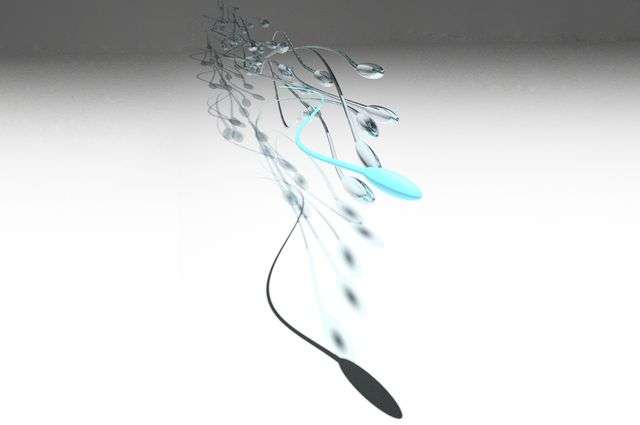New device reveals spinning head of sperm and gives scientists clearest view of its 3-D motion

Scientists have been observing sperm cells since the invention of the optical microscope. But surprisingly little has been known about sperm swimming patterns in 3-D – information that could help and improve scientists' understanding of the biophysics of sperm locomotion, which can shed light on key physical attributes of healthy and defect sperm.
Now, a microscope developed by researchers at the UCLA Henry Samueli School of Engineering and Applied Science and UCLA's California NanoSystems Institute (CNSI) has made it possible to precisely track the motion of sperm heads and tails in 3-D with unprecedented accuracy and detail. The device, which uses holography and image reconstruction algorithms, is described in a paper in Light: Science and Applications.
The work was led by Aydogan Ozcan, UCLA's Chancellor's Professor of Electrical and Computer Engineering and Bioengineering and an associate director of CNSI.
Most conventional microscopes in laboratories and clinical settings can only observe sperm's movement in 2-D and across a very small sample volume. Therefore they cannot capture 3-D details of sperm movement, like the spin of the sperm head or the rapid motion of its tail, or flagellum.
"Our holographic microscope replaces lenses with algorithms, and can image sperms over a sample volume that is approximately 100 times larger than that of standard optical microscopes," said Mustafa Daloglu, a UCLA doctoral student and first author of the study. "The data we collected allowed us to precisely observe the sperm movements in 3-D and reveal spinning sperm head and flagellar beating patterns in freely moving sperm, which could not be reported before our work."
First, the sperm sample is placed within a large observation chamber, more than 30 microliters in volume, on top of the image sensor. The two LEDs, which are placed outside of the container, are each slightly tilted with respect to each other, casting shadows of the moving sperms onto the image sensor.
"Because of how the two LEDs are positioned, each individual sperm generates two separate shadows from different angles – each containing holographic information that is used to reconstruct a digital 3-D image of the sperm body," said Wei Luo, a former UCLA doctoral student and co-author of the paper.
Not only will this imaging system be able to provide useful 3-D data to validate existing models and theories on sperm locomotion, it could also lead to new insights in micro-robotics.
"Understanding the spin of the sperm head and beating patterns of the flagellum could help engineers design more advanced microscale robots that would mimic the way that sperms move and sense their environment," Ozcan said.
Other members of the research team were UCLA undergraduates Francis Lin, Inje Lee, Vishwajith Ramesh, Kevin Kim, Jiaqi Jiang, Wenjun Cai and Mengyuan Yu, all participants in a research and training program established by Ozcan and funded by the Howard Hughes Medical Institute.
More information: Ozcan's research is supported by a Presidential Early Career Award for Scientists and Engineers, the Army Research Office, the National Science Foundation, the Office of Naval Research, the National Institutes of Health, the Howard Hughes Medical Institute, the Vodafone Americas Foundation, the Mary Kay Foundation and the Steven and Alexandra Cohen Foundation.
Journal information: Light: Science & Applications
Provided by UCLA Ozcan Research Group





















